HA3042 Taxation Law T1 2018: Income, Fringe Benefits & Capital Gains
VerifiedAdded on 2023/06/11
|7
|1900
|277
Homework Assignment
AI Summary
This taxation law assignment solution addresses several key areas. It analyzes whether payments received by Hilary for her story, manuscript, and photographs constitute income from personal exertion. The solution also computes the taxable value of a car fringe benefit, considering statutory formulas and employee-incurred expenses. Furthermore, it examines the tax treatment of a parent receiving funds from their son, distinguishing between principal repayment and potential gift income. Finally, the assignment delves into capital gains tax implications on the sale of land and a house, considering scenarios involving sales to family members and changes in ownership. Desklib offers a wealth of similar solved assignments and study resources for students.
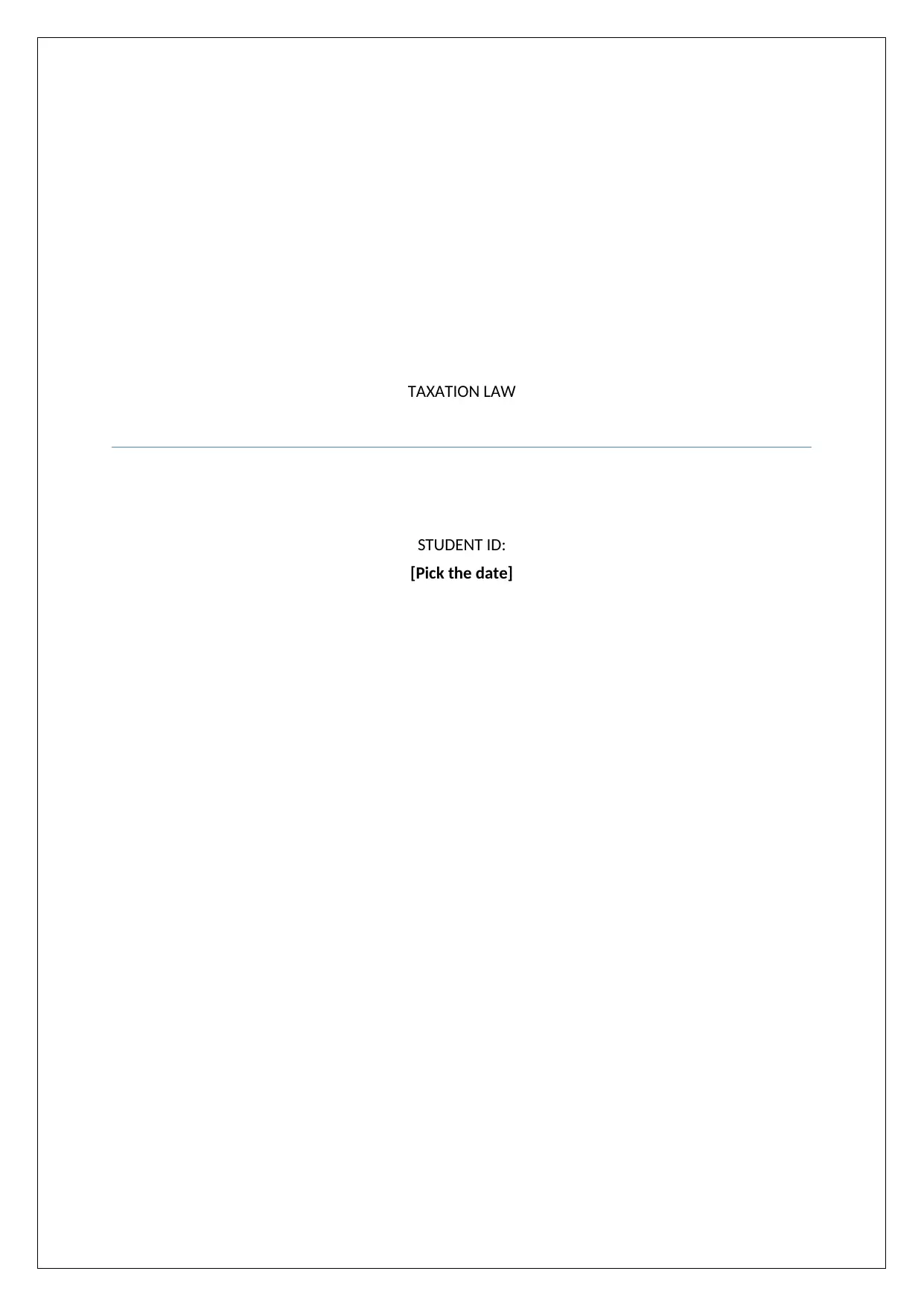
TAXATION LAW
STUDENT ID:
[Pick the date]
STUDENT ID:
[Pick the date]
Paraphrase This Document
Need a fresh take? Get an instant paraphrase of this document with our AI Paraphraser
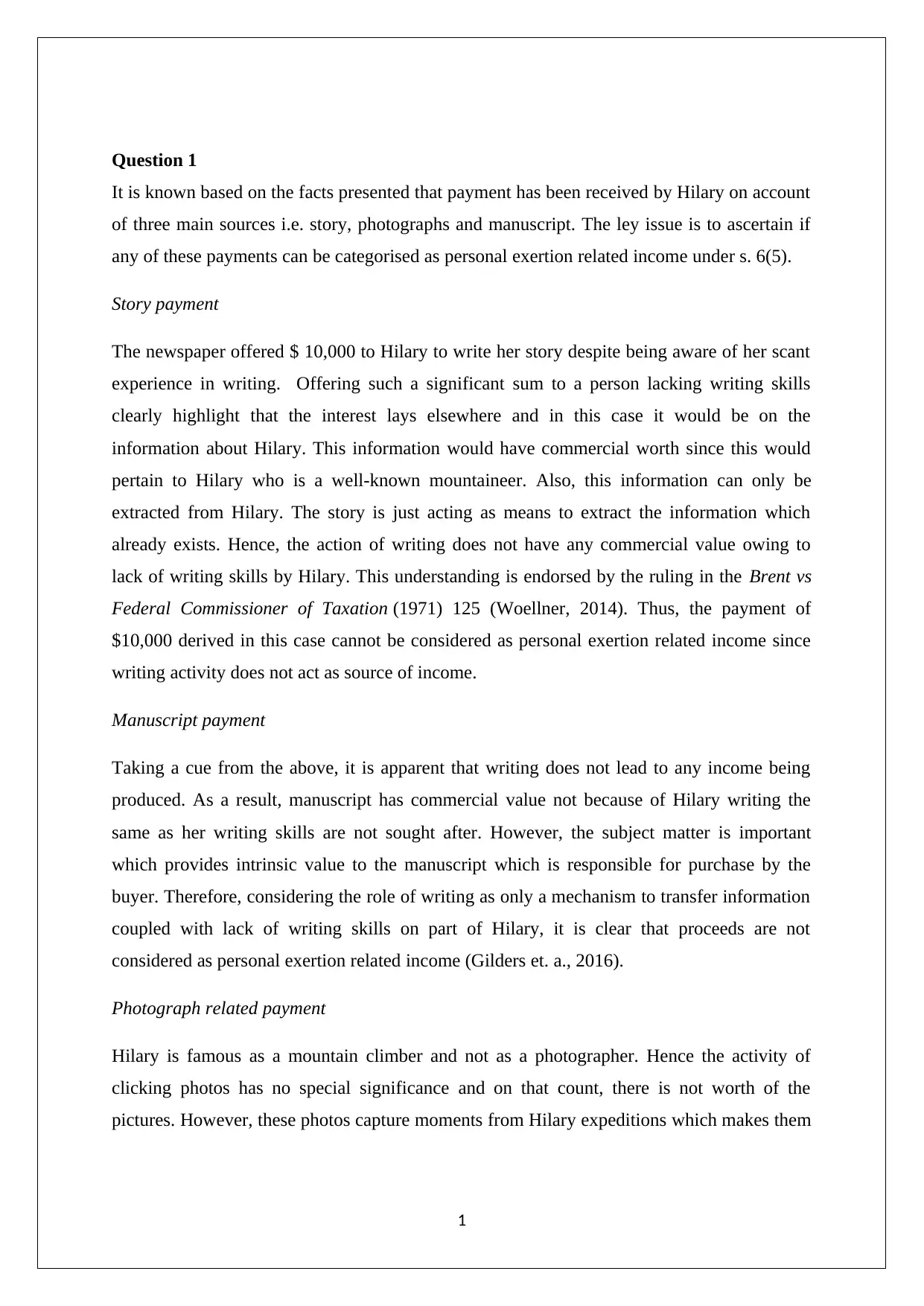
Question 1
It is known based on the facts presented that payment has been received by Hilary on account
of three main sources i.e. story, photographs and manuscript. The ley issue is to ascertain if
any of these payments can be categorised as personal exertion related income under s. 6(5).
Story payment
The newspaper offered $ 10,000 to Hilary to write her story despite being aware of her scant
experience in writing. Offering such a significant sum to a person lacking writing skills
clearly highlight that the interest lays elsewhere and in this case it would be on the
information about Hilary. This information would have commercial worth since this would
pertain to Hilary who is a well-known mountaineer. Also, this information can only be
extracted from Hilary. The story is just acting as means to extract the information which
already exists. Hence, the action of writing does not have any commercial value owing to
lack of writing skills by Hilary. This understanding is endorsed by the ruling in the Brent vs
Federal Commissioner of Taxation (1971) 125 (Woellner, 2014). Thus, the payment of
$10,000 derived in this case cannot be considered as personal exertion related income since
writing activity does not act as source of income.
Manuscript payment
Taking a cue from the above, it is apparent that writing does not lead to any income being
produced. As a result, manuscript has commercial value not because of Hilary writing the
same as her writing skills are not sought after. However, the subject matter is important
which provides intrinsic value to the manuscript which is responsible for purchase by the
buyer. Therefore, considering the role of writing as only a mechanism to transfer information
coupled with lack of writing skills on part of Hilary, it is clear that proceeds are not
considered as personal exertion related income (Gilders et. a., 2016).
Photograph related payment
Hilary is famous as a mountain climber and not as a photographer. Hence the activity of
clicking photos has no special significance and on that count, there is not worth of the
pictures. However, these photos capture moments from Hilary expeditions which makes them
1
It is known based on the facts presented that payment has been received by Hilary on account
of three main sources i.e. story, photographs and manuscript. The ley issue is to ascertain if
any of these payments can be categorised as personal exertion related income under s. 6(5).
Story payment
The newspaper offered $ 10,000 to Hilary to write her story despite being aware of her scant
experience in writing. Offering such a significant sum to a person lacking writing skills
clearly highlight that the interest lays elsewhere and in this case it would be on the
information about Hilary. This information would have commercial worth since this would
pertain to Hilary who is a well-known mountaineer. Also, this information can only be
extracted from Hilary. The story is just acting as means to extract the information which
already exists. Hence, the action of writing does not have any commercial value owing to
lack of writing skills by Hilary. This understanding is endorsed by the ruling in the Brent vs
Federal Commissioner of Taxation (1971) 125 (Woellner, 2014). Thus, the payment of
$10,000 derived in this case cannot be considered as personal exertion related income since
writing activity does not act as source of income.
Manuscript payment
Taking a cue from the above, it is apparent that writing does not lead to any income being
produced. As a result, manuscript has commercial value not because of Hilary writing the
same as her writing skills are not sought after. However, the subject matter is important
which provides intrinsic value to the manuscript which is responsible for purchase by the
buyer. Therefore, considering the role of writing as only a mechanism to transfer information
coupled with lack of writing skills on part of Hilary, it is clear that proceeds are not
considered as personal exertion related income (Gilders et. a., 2016).
Photograph related payment
Hilary is famous as a mountain climber and not as a photographer. Hence the activity of
clicking photos has no special significance and on that count, there is not worth of the
pictures. However, these photos capture moments from Hilary expeditions which makes them
1
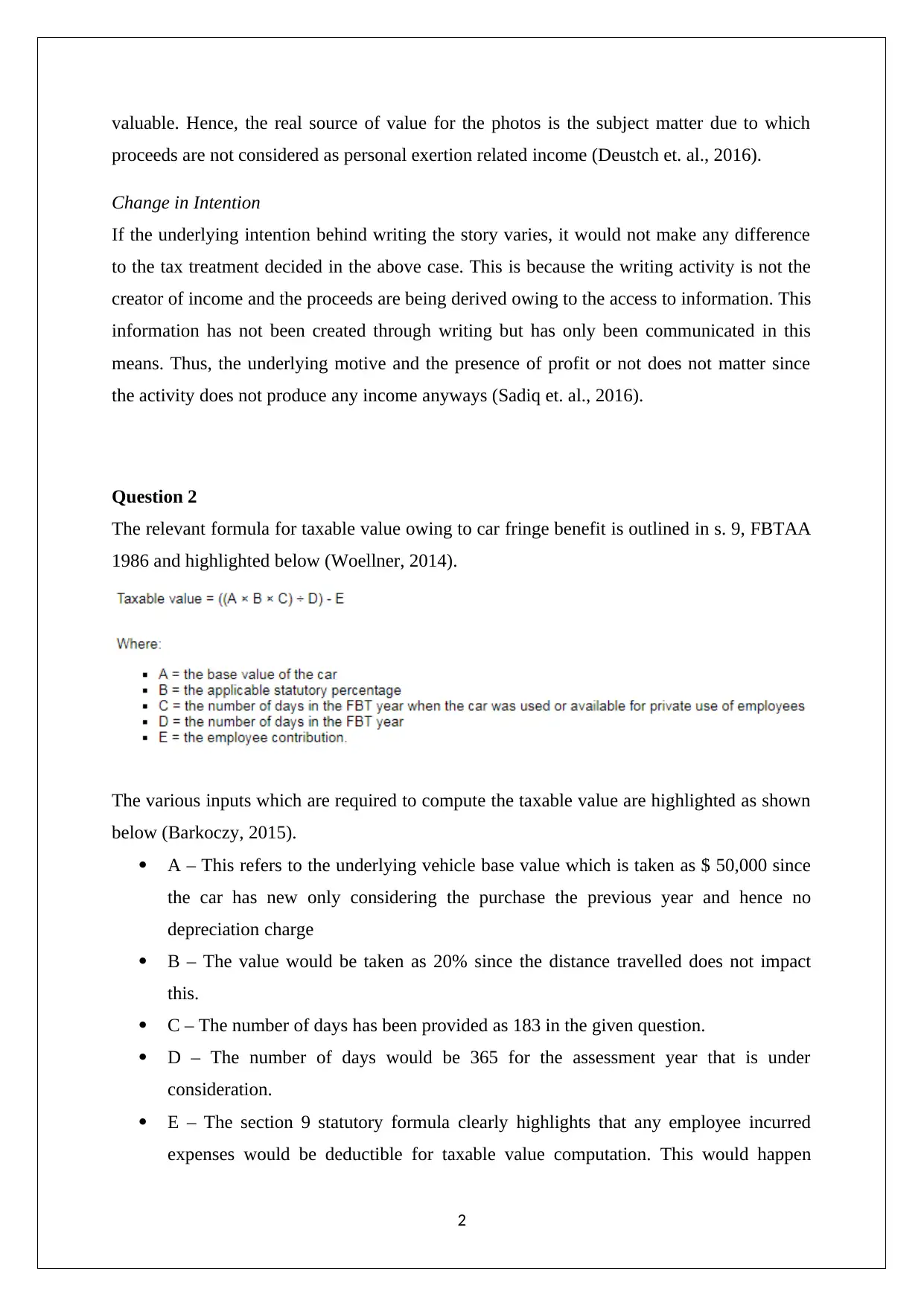
valuable. Hence, the real source of value for the photos is the subject matter due to which
proceeds are not considered as personal exertion related income (Deustch et. al., 2016).
Change in Intention
If the underlying intention behind writing the story varies, it would not make any difference
to the tax treatment decided in the above case. This is because the writing activity is not the
creator of income and the proceeds are being derived owing to the access to information. This
information has not been created through writing but has only been communicated in this
means. Thus, the underlying motive and the presence of profit or not does not matter since
the activity does not produce any income anyways (Sadiq et. al., 2016).
Question 2
The relevant formula for taxable value owing to car fringe benefit is outlined in s. 9, FBTAA
1986 and highlighted below (Woellner, 2014).
The various inputs which are required to compute the taxable value are highlighted as shown
below (Barkoczy, 2015).
A – This refers to the underlying vehicle base value which is taken as $ 50,000 since
the car has new only considering the purchase the previous year and hence no
depreciation charge
B – The value would be taken as 20% since the distance travelled does not impact
this.
C – The number of days has been provided as 183 in the given question.
D – The number of days would be 365 for the assessment year that is under
consideration.
E – The section 9 statutory formula clearly highlights that any employee incurred
expenses would be deductible for taxable value computation. This would happen
2
proceeds are not considered as personal exertion related income (Deustch et. al., 2016).
Change in Intention
If the underlying intention behind writing the story varies, it would not make any difference
to the tax treatment decided in the above case. This is because the writing activity is not the
creator of income and the proceeds are being derived owing to the access to information. This
information has not been created through writing but has only been communicated in this
means. Thus, the underlying motive and the presence of profit or not does not matter since
the activity does not produce any income anyways (Sadiq et. al., 2016).
Question 2
The relevant formula for taxable value owing to car fringe benefit is outlined in s. 9, FBTAA
1986 and highlighted below (Woellner, 2014).
The various inputs which are required to compute the taxable value are highlighted as shown
below (Barkoczy, 2015).
A – This refers to the underlying vehicle base value which is taken as $ 50,000 since
the car has new only considering the purchase the previous year and hence no
depreciation charge
B – The value would be taken as 20% since the distance travelled does not impact
this.
C – The number of days has been provided as 183 in the given question.
D – The number of days would be 365 for the assessment year that is under
consideration.
E – The section 9 statutory formula clearly highlights that any employee incurred
expenses would be deductible for taxable value computation. This would happen
2
⊘ This is a preview!⊘
Do you want full access?
Subscribe today to unlock all pages.

Trusted by 1+ million students worldwide
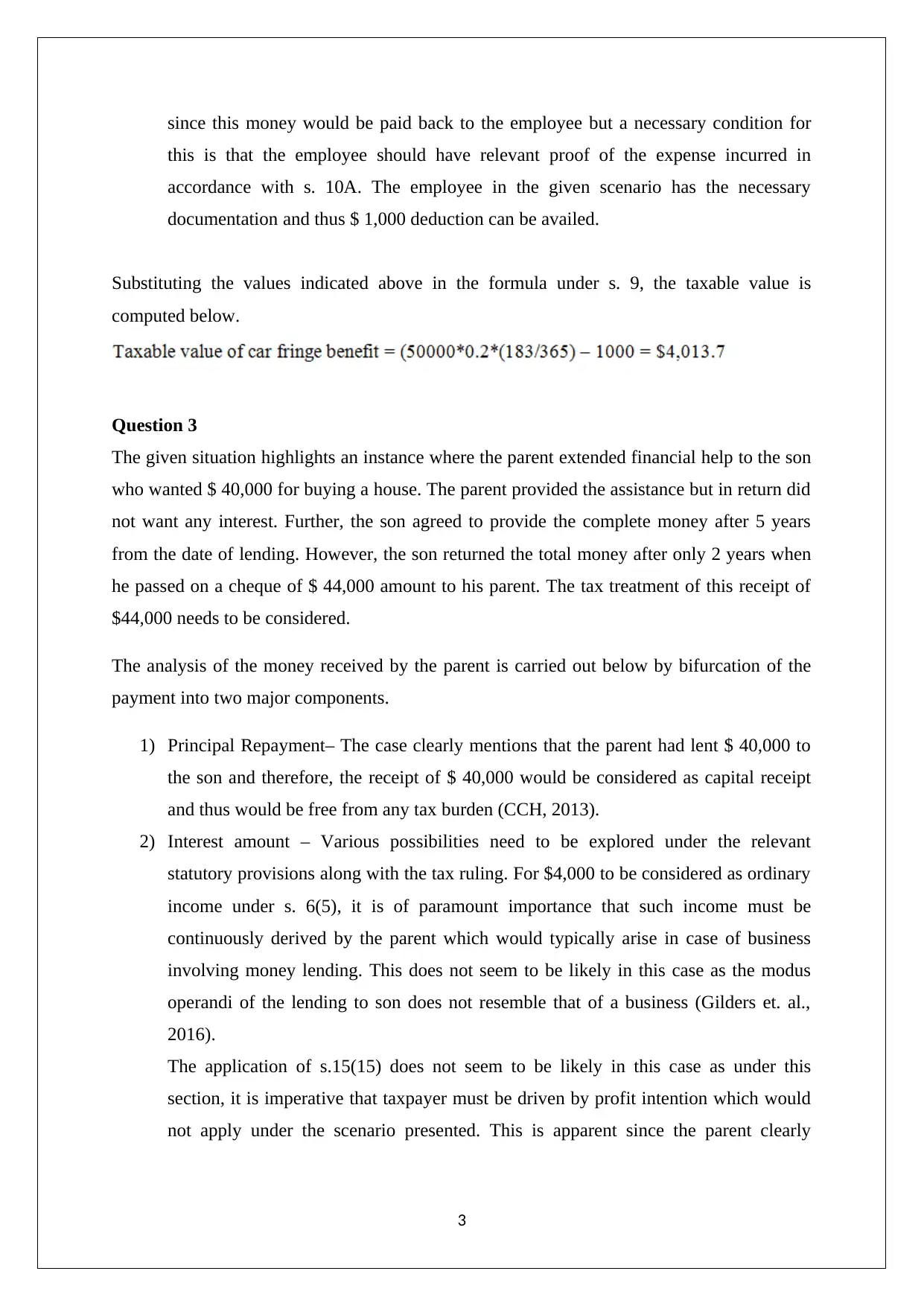
since this money would be paid back to the employee but a necessary condition for
this is that the employee should have relevant proof of the expense incurred in
accordance with s. 10A. The employee in the given scenario has the necessary
documentation and thus $ 1,000 deduction can be availed.
Substituting the values indicated above in the formula under s. 9, the taxable value is
computed below.
Question 3
The given situation highlights an instance where the parent extended financial help to the son
who wanted $ 40,000 for buying a house. The parent provided the assistance but in return did
not want any interest. Further, the son agreed to provide the complete money after 5 years
from the date of lending. However, the son returned the total money after only 2 years when
he passed on a cheque of $ 44,000 amount to his parent. The tax treatment of this receipt of
$44,000 needs to be considered.
The analysis of the money received by the parent is carried out below by bifurcation of the
payment into two major components.
1) Principal Repayment– The case clearly mentions that the parent had lent $ 40,000 to
the son and therefore, the receipt of $ 40,000 would be considered as capital receipt
and thus would be free from any tax burden (CCH, 2013).
2) Interest amount – Various possibilities need to be explored under the relevant
statutory provisions along with the tax ruling. For $4,000 to be considered as ordinary
income under s. 6(5), it is of paramount importance that such income must be
continuously derived by the parent which would typically arise in case of business
involving money lending. This does not seem to be likely in this case as the modus
operandi of the lending to son does not resemble that of a business (Gilders et. al.,
2016).
The application of s.15(15) does not seem to be likely in this case as under this
section, it is imperative that taxpayer must be driven by profit intention which would
not apply under the scenario presented. This is apparent since the parent clearly
3
this is that the employee should have relevant proof of the expense incurred in
accordance with s. 10A. The employee in the given scenario has the necessary
documentation and thus $ 1,000 deduction can be availed.
Substituting the values indicated above in the formula under s. 9, the taxable value is
computed below.
Question 3
The given situation highlights an instance where the parent extended financial help to the son
who wanted $ 40,000 for buying a house. The parent provided the assistance but in return did
not want any interest. Further, the son agreed to provide the complete money after 5 years
from the date of lending. However, the son returned the total money after only 2 years when
he passed on a cheque of $ 44,000 amount to his parent. The tax treatment of this receipt of
$44,000 needs to be considered.
The analysis of the money received by the parent is carried out below by bifurcation of the
payment into two major components.
1) Principal Repayment– The case clearly mentions that the parent had lent $ 40,000 to
the son and therefore, the receipt of $ 40,000 would be considered as capital receipt
and thus would be free from any tax burden (CCH, 2013).
2) Interest amount – Various possibilities need to be explored under the relevant
statutory provisions along with the tax ruling. For $4,000 to be considered as ordinary
income under s. 6(5), it is of paramount importance that such income must be
continuously derived by the parent which would typically arise in case of business
involving money lending. This does not seem to be likely in this case as the modus
operandi of the lending to son does not resemble that of a business (Gilders et. al.,
2016).
The application of s.15(15) does not seem to be likely in this case as under this
section, it is imperative that taxpayer must be driven by profit intention which would
not apply under the scenario presented. This is apparent since the parent clearly
3
Paraphrase This Document
Need a fresh take? Get an instant paraphrase of this document with our AI Paraphraser
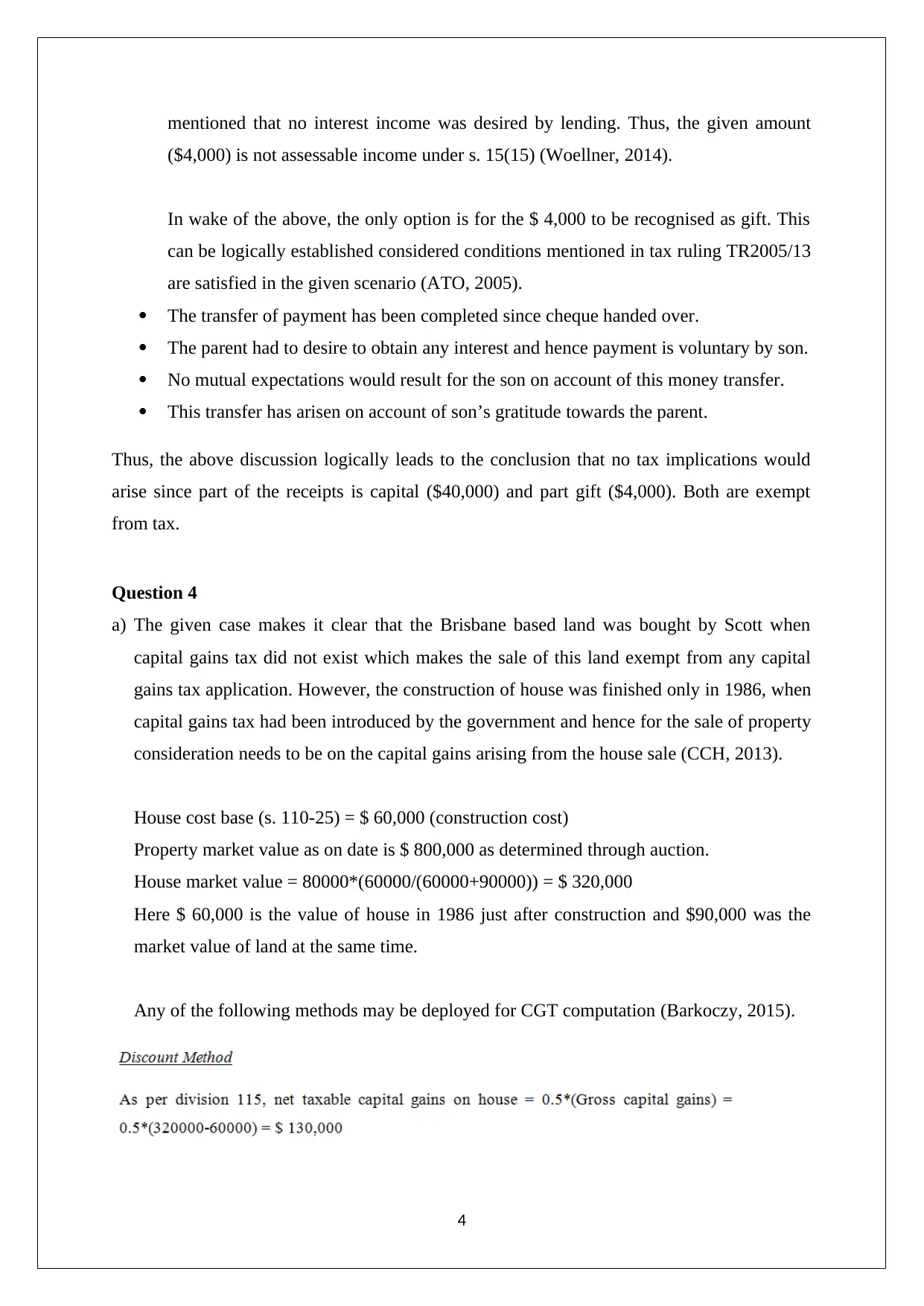
mentioned that no interest income was desired by lending. Thus, the given amount
($4,000) is not assessable income under s. 15(15) (Woellner, 2014).
In wake of the above, the only option is for the $ 4,000 to be recognised as gift. This
can be logically established considered conditions mentioned in tax ruling TR2005/13
are satisfied in the given scenario (ATO, 2005).
The transfer of payment has been completed since cheque handed over.
The parent had to desire to obtain any interest and hence payment is voluntary by son.
No mutual expectations would result for the son on account of this money transfer.
This transfer has arisen on account of son’s gratitude towards the parent.
Thus, the above discussion logically leads to the conclusion that no tax implications would
arise since part of the receipts is capital ($40,000) and part gift ($4,000). Both are exempt
from tax.
Question 4
a) The given case makes it clear that the Brisbane based land was bought by Scott when
capital gains tax did not exist which makes the sale of this land exempt from any capital
gains tax application. However, the construction of house was finished only in 1986, when
capital gains tax had been introduced by the government and hence for the sale of property
consideration needs to be on the capital gains arising from the house sale (CCH, 2013).
House cost base (s. 110-25) = $ 60,000 (construction cost)
Property market value as on date is $ 800,000 as determined through auction.
House market value = 80000*(60000/(60000+90000)) = $ 320,000
Here $ 60,000 is the value of house in 1986 just after construction and $90,000 was the
market value of land at the same time.
Any of the following methods may be deployed for CGT computation (Barkoczy, 2015).
4
($4,000) is not assessable income under s. 15(15) (Woellner, 2014).
In wake of the above, the only option is for the $ 4,000 to be recognised as gift. This
can be logically established considered conditions mentioned in tax ruling TR2005/13
are satisfied in the given scenario (ATO, 2005).
The transfer of payment has been completed since cheque handed over.
The parent had to desire to obtain any interest and hence payment is voluntary by son.
No mutual expectations would result for the son on account of this money transfer.
This transfer has arisen on account of son’s gratitude towards the parent.
Thus, the above discussion logically leads to the conclusion that no tax implications would
arise since part of the receipts is capital ($40,000) and part gift ($4,000). Both are exempt
from tax.
Question 4
a) The given case makes it clear that the Brisbane based land was bought by Scott when
capital gains tax did not exist which makes the sale of this land exempt from any capital
gains tax application. However, the construction of house was finished only in 1986, when
capital gains tax had been introduced by the government and hence for the sale of property
consideration needs to be on the capital gains arising from the house sale (CCH, 2013).
House cost base (s. 110-25) = $ 60,000 (construction cost)
Property market value as on date is $ 800,000 as determined through auction.
House market value = 80000*(60000/(60000+90000)) = $ 320,000
Here $ 60,000 is the value of house in 1986 just after construction and $90,000 was the
market value of land at the same time.
Any of the following methods may be deployed for CGT computation (Barkoczy, 2015).
4
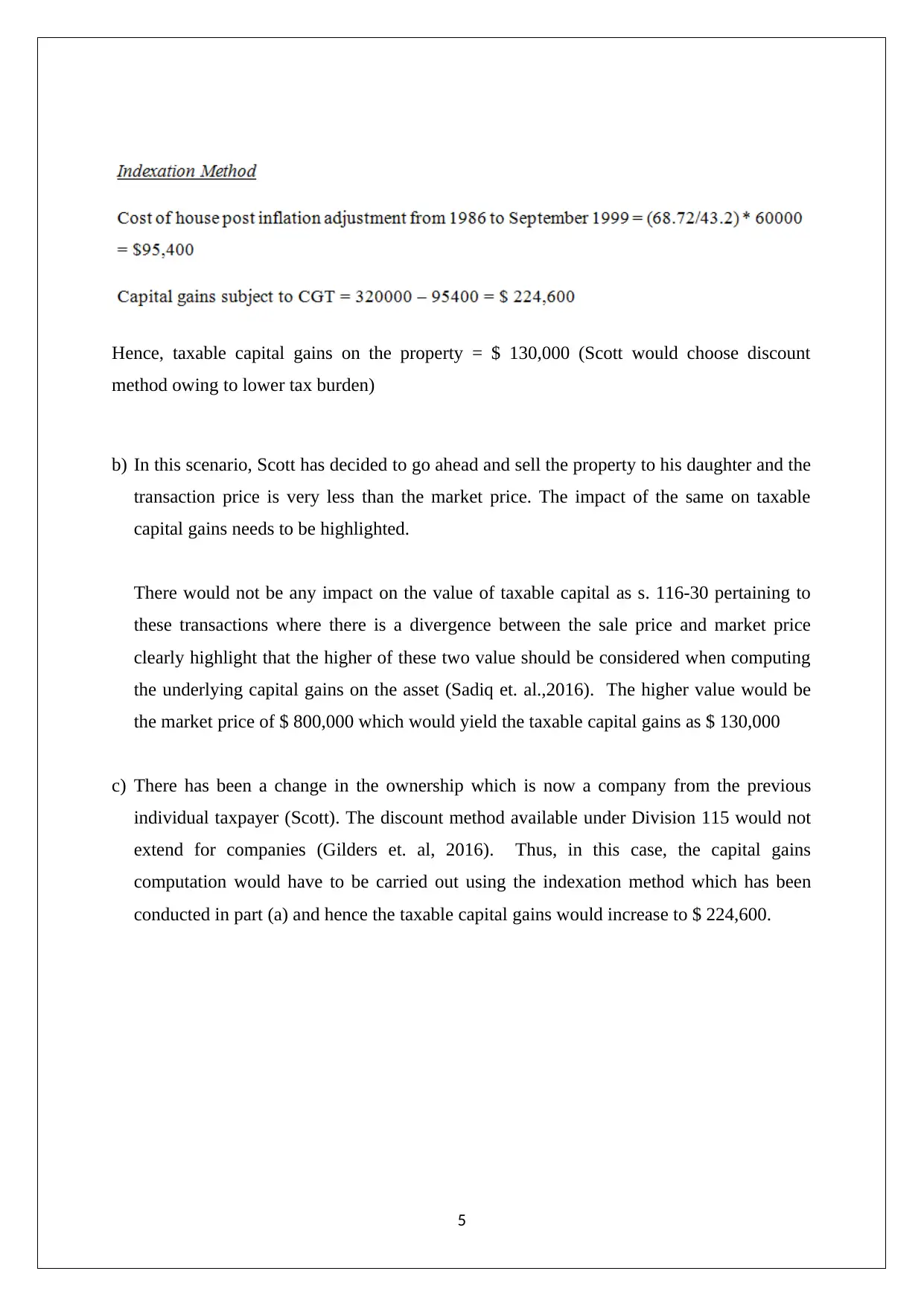
Hence, taxable capital gains on the property = $ 130,000 (Scott would choose discount
method owing to lower tax burden)
b) In this scenario, Scott has decided to go ahead and sell the property to his daughter and the
transaction price is very less than the market price. The impact of the same on taxable
capital gains needs to be highlighted.
There would not be any impact on the value of taxable capital as s. 116-30 pertaining to
these transactions where there is a divergence between the sale price and market price
clearly highlight that the higher of these two value should be considered when computing
the underlying capital gains on the asset (Sadiq et. al.,2016). The higher value would be
the market price of $ 800,000 which would yield the taxable capital gains as $ 130,000
c) There has been a change in the ownership which is now a company from the previous
individual taxpayer (Scott). The discount method available under Division 115 would not
extend for companies (Gilders et. al, 2016). Thus, in this case, the capital gains
computation would have to be carried out using the indexation method which has been
conducted in part (a) and hence the taxable capital gains would increase to $ 224,600.
5
method owing to lower tax burden)
b) In this scenario, Scott has decided to go ahead and sell the property to his daughter and the
transaction price is very less than the market price. The impact of the same on taxable
capital gains needs to be highlighted.
There would not be any impact on the value of taxable capital as s. 116-30 pertaining to
these transactions where there is a divergence between the sale price and market price
clearly highlight that the higher of these two value should be considered when computing
the underlying capital gains on the asset (Sadiq et. al.,2016). The higher value would be
the market price of $ 800,000 which would yield the taxable capital gains as $ 130,000
c) There has been a change in the ownership which is now a company from the previous
individual taxpayer (Scott). The discount method available under Division 115 would not
extend for companies (Gilders et. al, 2016). Thus, in this case, the capital gains
computation would have to be carried out using the indexation method which has been
conducted in part (a) and hence the taxable capital gains would increase to $ 224,600.
5
⊘ This is a preview!⊘
Do you want full access?
Subscribe today to unlock all pages.

Trusted by 1+ million students worldwide
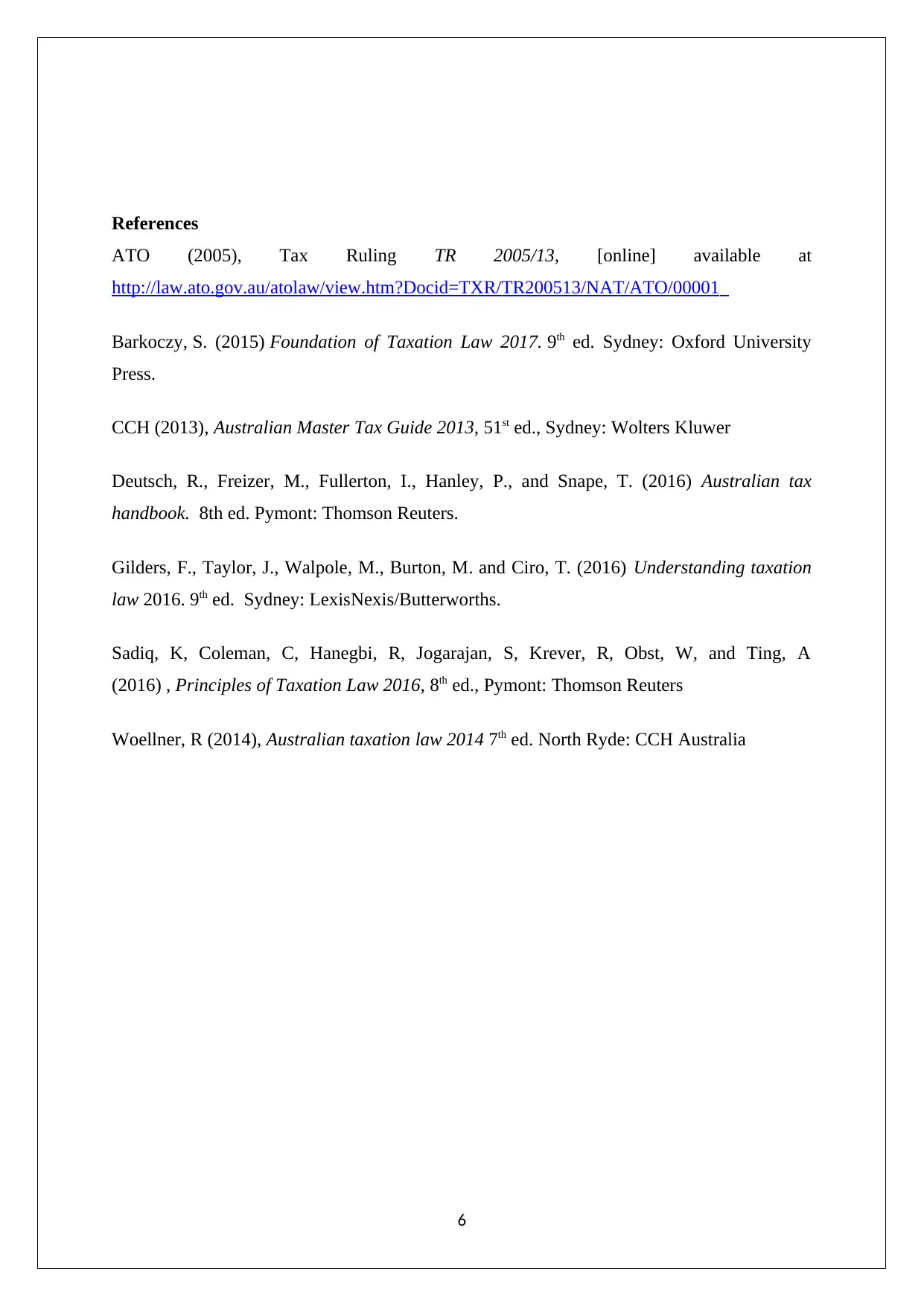
References
ATO (2005), Tax Ruling TR 2005/13, [online] available at
http://law.ato.gov.au/atolaw/view.htm?Docid=TXR/TR200513/NAT/ATO/00001
Barkoczy, S. (2015) Foundation of Taxation Law 2017. 9th ed. Sydney: Oxford University
Press.
CCH (2013), Australian Master Tax Guide 2013, 51st ed., Sydney: Wolters Kluwer
Deutsch, R., Freizer, M., Fullerton, I., Hanley, P., and Snape, T. (2016) Australian tax
handbook. 8th ed. Pymont: Thomson Reuters.
Gilders, F., Taylor, J., Walpole, M., Burton, M. and Ciro, T. (2016) Understanding taxation
law 2016. 9th ed. Sydney: LexisNexis/Butterworths.
Sadiq, K, Coleman, C, Hanegbi, R, Jogarajan, S, Krever, R, Obst, W, and Ting, A
(2016) , Principles of Taxation Law 2016, 8th ed., Pymont: Thomson Reuters
Woellner, R (2014), Australian taxation law 2014 7th ed. North Ryde: CCH Australia
6
ATO (2005), Tax Ruling TR 2005/13, [online] available at
http://law.ato.gov.au/atolaw/view.htm?Docid=TXR/TR200513/NAT/ATO/00001
Barkoczy, S. (2015) Foundation of Taxation Law 2017. 9th ed. Sydney: Oxford University
Press.
CCH (2013), Australian Master Tax Guide 2013, 51st ed., Sydney: Wolters Kluwer
Deutsch, R., Freizer, M., Fullerton, I., Hanley, P., and Snape, T. (2016) Australian tax
handbook. 8th ed. Pymont: Thomson Reuters.
Gilders, F., Taylor, J., Walpole, M., Burton, M. and Ciro, T. (2016) Understanding taxation
law 2016. 9th ed. Sydney: LexisNexis/Butterworths.
Sadiq, K, Coleman, C, Hanegbi, R, Jogarajan, S, Krever, R, Obst, W, and Ting, A
(2016) , Principles of Taxation Law 2016, 8th ed., Pymont: Thomson Reuters
Woellner, R (2014), Australian taxation law 2014 7th ed. North Ryde: CCH Australia
6
1 out of 7
Related Documents
Your All-in-One AI-Powered Toolkit for Academic Success.
+13062052269
info@desklib.com
Available 24*7 on WhatsApp / Email
![[object Object]](/_next/static/media/star-bottom.7253800d.svg)
Unlock your academic potential
Copyright © 2020–2025 A2Z Services. All Rights Reserved. Developed and managed by ZUCOL.





